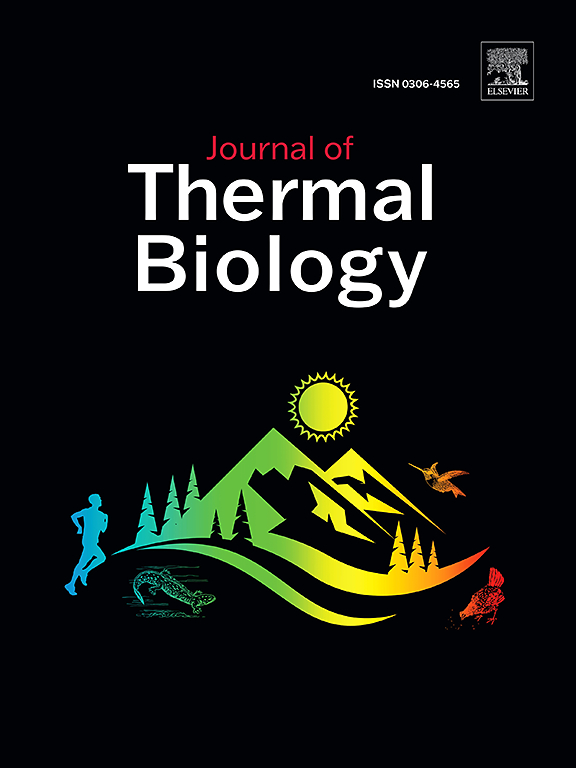Comparative analysis of thermoregulation models to assess heat strain in moderate to extreme heat
IF 2.9
2区 生物学
Q2 BIOLOGY
引用次数: 0
Abstract
As global temperatures rise due to climate change, the frequency and intensity of heatwaves are increasing, posing significant threats to human health, productivity, and well-being. Thermoregulation models are important tools for quantifying the risk of extreme heat, providing insights into physiological strain indicators such as core and skin temperatures, sweat rates, and thermal comfort levels. This study evaluated four thermoregulation models of varying complexity, differentiated by the geometry and underlying thermoregulatory mechanisms. The models assessed include the Gagge two-node model, the Stolwijk-1971 model, the JOS3 model, and the UTCI-Fiala model. Additionally, we introduce the Stolwijk-2024 model, a modified version of the original Stolwijk model, which incorporates updated empirical coefficients derived from recent studies while retaining the original framework. The models were tested against human trial data across a wide range of extreme heat exposures, including transient extreme heat, humid heat, various physical activity levels, and clothing insulation scenarios. Our findings demonstrate that multi-node and multi-segment models, such as JOS3, UTCI-Fiala, and Stolwijk-2024, reliably predict core (average RMSD: <0.3 °C) and skin (average root-mean-square deviation, RMSD: <0.6 °C) temperatures, making them suitable for assessing heat strain and thermal comfort in moderate to extreme environmental conditions. In contrast, simpler models like the single-segment, two-node Gagge's model performed poorly in predicting core temperature under conditions involving high metabolic rates (>3.75 met) in moderate to hot environments (>35 °C), with an average RMSD of 1.2 °C. Similarly, the Stolwijk-1971 model showed a systematic bias (∼0.45 °C), underpredicting core temperatures during high metabolic rates. This study underscores the robustness and applicability of open-source models like JOS3 and Stolwijk-2024 in public health, urban design, and climate impact research, highlighting their potential to improve our understanding of heat strain and thermal comfort in the context of a warming climate.
热调节模型的比较分析,以评估热应变在中等至极端热。
由于气候变化导致全球气温上升,热浪的频率和强度正在增加,对人类健康、生产力和福祉构成重大威胁。体温调节模型是量化极端高温风险的重要工具,提供了对生理应变指标的见解,如核心和皮肤温度、出汗率和热舒适度。本研究评估了四种不同复杂性的热调节模型,根据几何形状和潜在的热调节机制进行了区分。评估的模型包括Gagge双节点模型、Stolwijk-1971模型、JOS3模型和UTCI-Fiala模型。此外,我们引入了Stolwijk-2024模型,这是原始Stolwijk模型的修改版本,它在保留原始框架的同时纳入了最新研究得出的更新的经验系数。这些模型在广泛的极端高温暴露下进行了人体试验数据测试,包括短暂的极端高温、湿热、各种身体活动水平和衣服绝缘情况。研究结果表明,JOS3、UTCI-Fiala和Stolwijk-2024等多节点多段模型可以可靠地预测中高温环境(> - 35°C)的岩芯(平均RMSD: 3.75 met),平均RMSD为1.2°C。同样,Stolwijk-1971模型显示出系统偏差(~ 0.45°C),低估了高代谢率期间的核心温度。该研究强调了JOS3和Stolwijk-2024等开源模型在公共卫生、城市设计和气候影响研究中的稳健性和适用性,强调了它们在气候变暖背景下提高我们对热应变和热舒适理解的潜力。
本文章由计算机程序翻译,如有差异,请以英文原文为准。
求助全文
约1分钟内获得全文
求助全文
来源期刊

Journal of thermal biology
生物-动物学
CiteScore
5.30
自引率
7.40%
发文量
196
审稿时长
14.5 weeks
期刊介绍:
The Journal of Thermal Biology publishes articles that advance our knowledge on the ways and mechanisms through which temperature affects man and animals. This includes studies of their responses to these effects and on the ecological consequences. Directly relevant to this theme are:
• The mechanisms of thermal limitation, heat and cold injury, and the resistance of organisms to extremes of temperature
• The mechanisms involved in acclimation, acclimatization and evolutionary adaptation to temperature
• Mechanisms underlying the patterns of hibernation, torpor, dormancy, aestivation and diapause
• Effects of temperature on reproduction and development, growth, ageing and life-span
• Studies on modelling heat transfer between organisms and their environment
• The contributions of temperature to effects of climate change on animal species and man
• Studies of conservation biology and physiology related to temperature
• Behavioural and physiological regulation of body temperature including its pathophysiology and fever
• Medical applications of hypo- and hyperthermia
Article types:
• Original articles
• Review articles
 求助内容:
求助内容: 应助结果提醒方式:
应助结果提醒方式:


